Understanding What Happens After Death
When someone passes away, their body is typically taken to either a mortuary or morgue for temporary storage and preparation. If you're trying to understand the difference:
| Facility | Primary Purpose | Location | Services |
|---|---|---|---|
| Morgue | Temporary storage and forensic examination | Usually in hospitals or medical examiner's offices | Autopsy, identification, evidence collection |
| Mortuary | Preparation for funeral services | Usually in or connected to funeral homes | Embalming, cosmetic preparation, viewing arrangements |
The terms are often used interchangeably, but they serve different functions in the death care process. In the United States, "morgue" typically refers to a medical facility for temporary storage and autopsy, while "mortuary" usually means a funeral home where bodies are prepared for burial or cremation.
When a death occurs, understanding where the body goes first can help reduce stress during an already difficult time. Typically, if a death requires investigation, the body will go to a morgue first. For natural deaths in hospitals or hospice, the body may go directly to a mortuary if no autopsy is required.
Bodies in both facilities are stored in refrigerated units at temperatures between 2°C (36°F) and 4°C (39°F) to slow decomposition until further arrangements can be made.
I'm American Mortuary Coolers, a national supplier of mortuary refrigeration systems with extensive experience providing cooling solutions for both mortuaries and morgues across the United States.
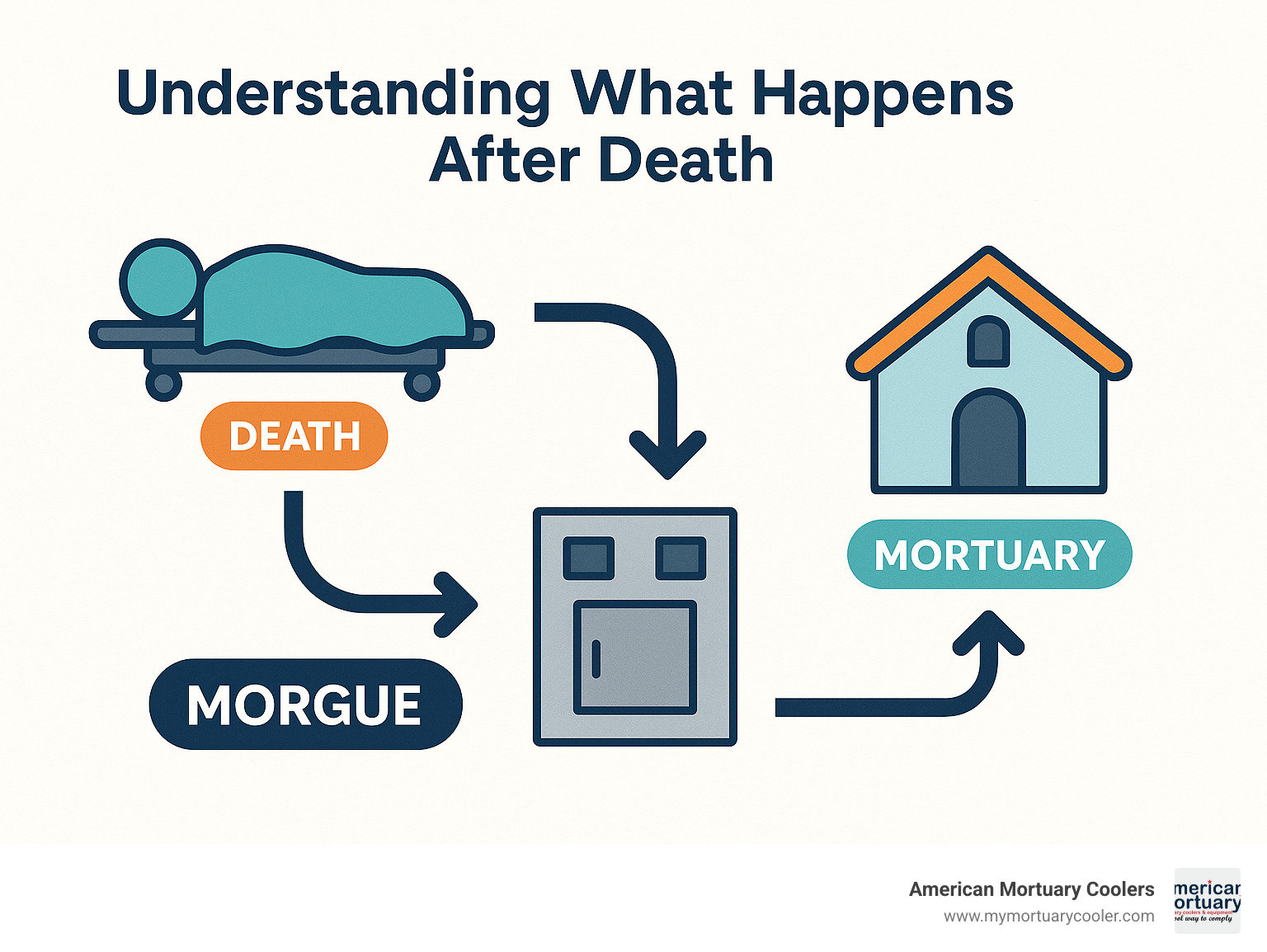
Mortuary or morgue terms you need:
Why This Guide Matters
Navigating the aftermath of a loved one's death is challenging enough without the added confusion of unfamiliar terminology and processes. This guide aims to clarify the distinctions between a mortuary or morgue, reducing the stress associated with making quick decisions during a time of grief.
Understanding these differences becomes crucial when you need to:
- Locate where a loved one has been taken after death
- Make arrangements for transfer to a funeral home
- Coordinate with medical examiners for autopsy results
- Plan cultural or religious ceremonies within specific timeframes
Understanding the Basics: Mortuary vs. Morgue
Ever wondered about the difference between a mortuary or morgue? Though often used interchangeably, these terms actually refer to distinct facilities with different purposes in the death care journey.
The word "morgue" comes from a specific building in Paris called "La Morgue" in the 1800s, which replaced the earlier term "dead house." The French word "morguer" means "to look at solemnly." Meanwhile, "mortuary" has Latin roots, deriving from "mortuarius," which relates to the dead.
In the United States, when we say morgue, we're typically referring to a facility within a hospital or medical examiner's office where bodies are temporarily kept for identification, examination, or autopsy. A mortuary, on the other hand, is generally part of a funeral home where loved ones are prepared for their final farewell.
Interestingly, in the United Kingdom or Australia, you'll hear "mortuary" used more commonly for both types of facilities.
What Is a Mortuary or Morgue?
Both a mortuary or morgue serves as a crucial bridge between the moment of passing and final disposition.
A morgue primarily functions as a medical facility designed for forensic examination or autopsy if needed. Morgues also provide identification services and collect evidence when required. In teaching hospitals, they may also serve educational purposes.
When you walk into a morgue, you'd find specialized equipment like refrigerated storage units maintaining temperatures between 2-4°C, autopsy tables with drainage systems, medical imaging equipment, and laboratory facilities.
A mortuary, particularly in American funeral homes, focuses on preparing the deceased for viewing and funeral services. This includes embalming and preservation, cosmetic restoration, and dressing services. Modern mortuaries create spaces where families can begin their grieving process with dignity.
Inside a typical mortuary, you'll find preparation rooms with specialized embalming equipment, comfortable viewing rooms for families, storage facilities, and areas displaying caskets and urns.
Key Differences At-a-Glance
Understanding the distinctions between a mortuary or morgue helps clarify their unique roles:
| Aspect | Morgue | Mortuary |
|---|---|---|
| Primary Purpose | Medical examination and temporary storage | Preparation for funeral services |
| Typical Location | Hospitals, medical examiner offices | Funeral homes |
| Staff | Medical examiners, forensic pathologists, morgue technicians | Funeral directors, embalmers, mortuary assistants |
| Key Procedures | Autopsy, identification, evidence collection | Embalming, cosmetic preparation, dressing |
| Family Involvement | Limited, mainly for identification | Extensive, including viewings and services |
The heart of the difference lies in their purpose: morgues address medical and legal needs, while mortuaries serve funeral and ceremonial needs.
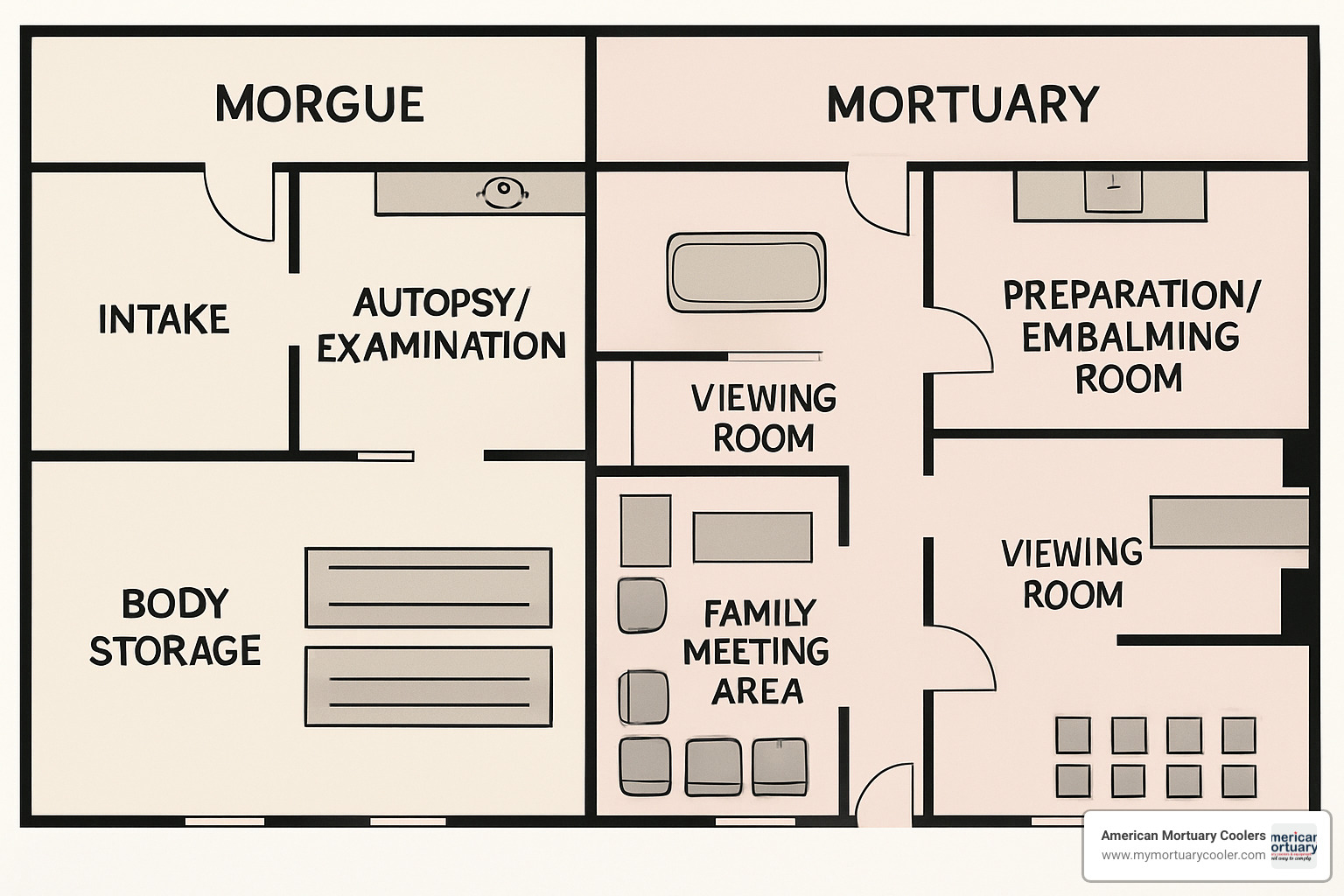
If you were to compare the floor plans of these facilities, you'd notice telling differences. Morgues prioritize efficiency for medical procedures, while mortuaries balance technical preparation areas with spaces designed to comfort grieving families.
Scientific research on morgue refrigeration has established that proper temperature control is vital in both settings, though for different reasons.
At American Mortuary Coolers, we understand the specific refrigeration needs of both settings, which is why we've created detailed resources about cooler requirements for professionals in the death care industry.
The Journey of a Body: Step-by-Step Process
When someone passes away, their physical remains begin a carefully managed journey through our death care system. Understanding this process can bring some comfort during a difficult time.
The journey begins when a medical professional officially pronounces death and issues a preliminary death certificate. Depending on where the death occurs, different professionals handle the initial transport – hospital staff, emergency services, funeral home staff, or medical examiners.
Upon arrival at either a mortuary or morgue, staff create detailed documentation recording the person's identity, arrival time, body condition, and personal belongings.
What happens next varies based on circumstances. In a morgue setting, medical examination and possible autopsy take priority, while a mortuary begins assessing preparation needs for funeral services. Either way, refrigerated storage provides a dignified resting place until next steps are determined.
The final phase involves release to authorized individuals – typically from morgue to funeral home, or from mortuary to the place of final disposition. The journey concludes with burial, cremation, or other arrangements according to family wishes.
Does the Body Go to a Mortuary or Morgue First?
Whether your loved one goes to a mortuary or morgue first depends largely on how and where they passed away.
When death occurs unexpectedly or under certain circumstances, the body typically goes to a morgue first. This includes sudden deaths, passings outside medical supervision, cases needing investigation, accidents, homicides, suicides, deaths with unknown causes, or when identification is needed.
In contrast, when someone passes from natural causes with a known medical history, they often go directly to a mortuary. This includes deaths under hospice care, situations where a doctor can immediately sign the death certificate, and cases not requiring autopsy.
When a death falls under medical examiner or coroner jurisdiction, the body must legally go to a morgue first, even if family members request otherwise.
Inside the Morgue: Autopsy & Forensics
Modern morgues are sophisticated medical facilities specifically designed for examining deceased individuals and determining cause of death.
The team working in a morgue includes several key professionals: Forensic pathologists determine cause and manner of death, Medical examiners investigate deaths in their official capacity, Dieners (morgue technicians) assist with autopsies, while forensic investigators collect and analyze evidence.
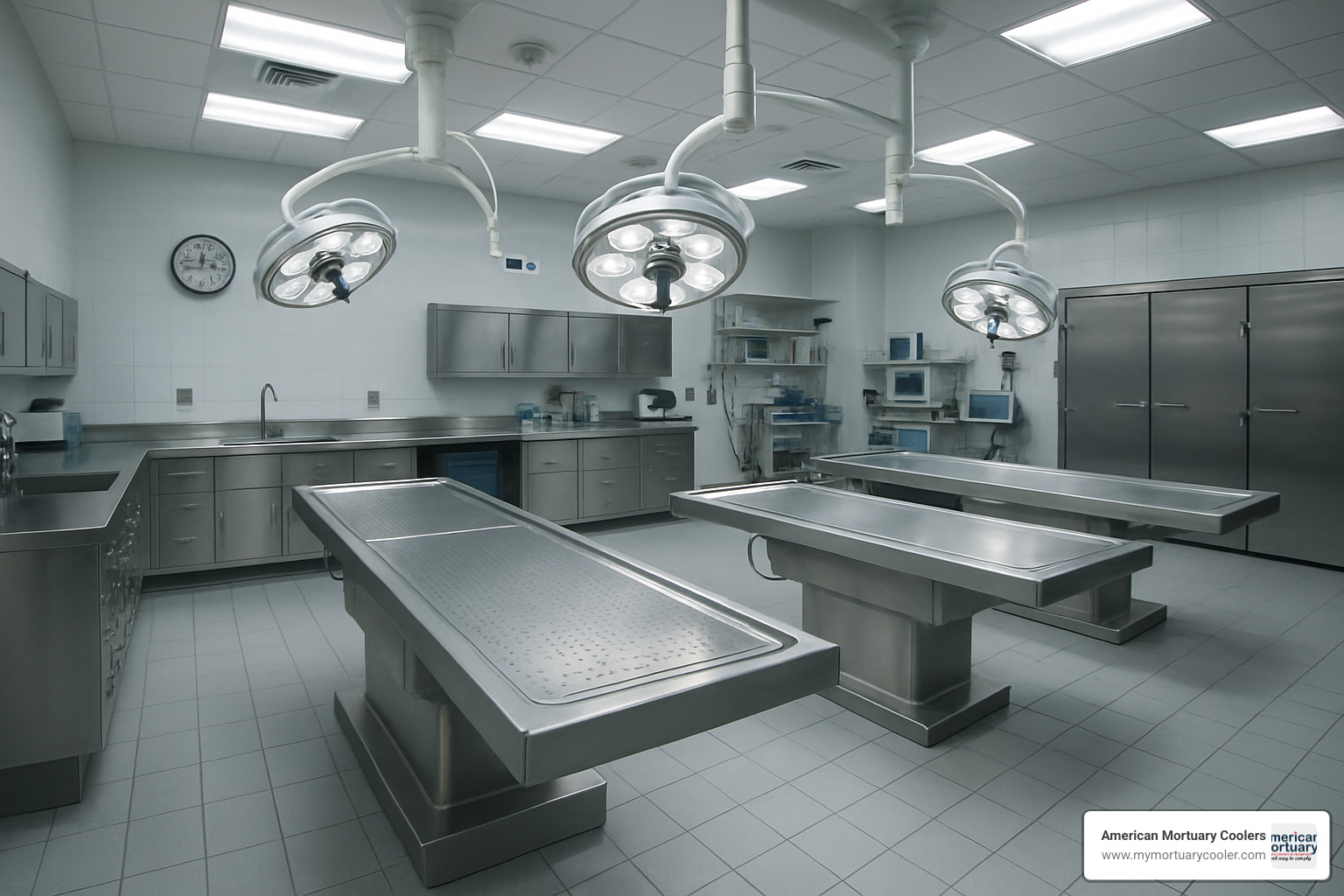
During an autopsy, pathologists begin with an external examination, documenting any injuries or abnormalities. They collect samples for toxicology and other laboratory tests, then conduct an internal examination of organs and tissues.
The refrigeration systems in morgues are absolutely critical. Bodies are maintained at temperatures between 2-4°C (36-39°F) for short-term storage, preserving them with dignity while slowing natural processes.
Inside the Mortuary: Preparation & Viewing
While morgues serve primarily medical and legal functions, mortuaries balance technical requirements with creating comfort for grieving families.
The mortuary team includes funeral directors who coordinate arrangements, embalmers who apply specialized preservation techniques, mortuary assistants who help with preparation, and funeral attendants who support families during services.
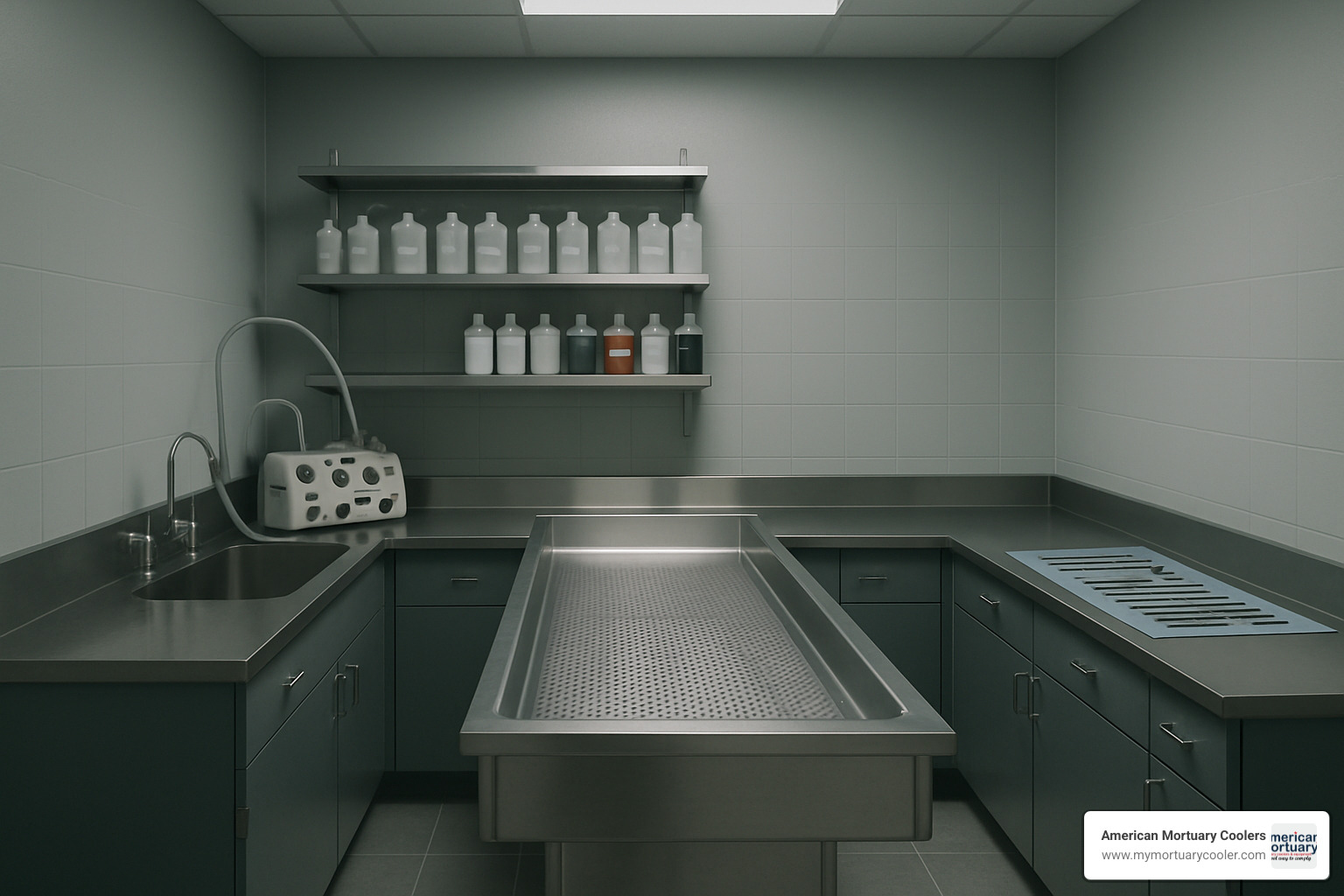
When embalming is chosen, the process begins with gentle washing and disinfecting, followed by replacing blood with embalming fluid through the arterial system. Embalmers treat body cavities with preservative chemicals, close any wounds, apply cosmetics, style hair, and dress the deceased in clothes provided by the family.
The viewing rooms in mortuaries are thoughtfully designed to create a peaceful, dignified atmosphere where families can spend time with their loved one.
More info about morgue refrigerators
How to Choose the Right Facility Near You
Navigating mortuary or morgue facilities can feel overwhelming, especially during an already difficult time. While families rarely choose a morgue (since this is typically determined by jurisdiction), understanding both types of facilities helps you make more confident decisions about funeral arrangements.
When looking for a mortuary or funeral home, consider several important factors:
- Verify proper state licensing and credentials
- Assess the facility's capacity and capabilities for your needs
- Confirm they can accommodate any religious or cultural requirements
- Consider the location's convenience for family members
- Research the facility's reputation through reviews and recommendations
- Request clear pricing information and transparency about all costs
- Trust your instincts about the staff's empathy and professionalism
During public health emergencies or mass fatality events, temporary morgue facilities may be established in your area. Understanding these contingency plans can be helpful during unusual situations.
Questions to Ask When Calling a Mortuary or Morgue
Having a prepared list of questions when contacting a mortuary or morgue helps ensure you gather all the information you need during what might be an emotionally difficult conversation.
When calling a morgue (typically when identifying or claiming a body), ask about:
- Operating hours for family visits
- Identification requirements
- Whether an appointment is necessary
- The process for transferring to a funeral home
- Whether an autopsy has been performed
- Any storage or release fees
- How to claim personal effects
For mortuaries or funeral homes, ask about:
- Range of services offered
- Religious or cultural accommodation
- Viewing options and hours
- Pricing structure and payment options
- Preparation alternatives to embalming
- Timeframes for different services
- Whether they handle all necessary paperwork
Take notes during these conversations and request written information when possible to help you compare options thoughtfully.
Can One Building House Both?
Yes, a single facility can house both a mortuary and morgue, though this arrangement varies depending on the context.
Hospital-based facilities often maintain this dual function, with a morgue area for temporary storage and autopsy, alongside a basic mortuary area for preparation before transfer to funeral homes.
Medical examiner or coroner facilities frequently combine these functions too, including forensic morgue areas for investigation and basic mortuary services for preparation after examination.
Some larger funeral homes have evolved to include areas designated as morgue space for temporary holding, full mortuary preparation rooms, and dedicated viewing spaces.
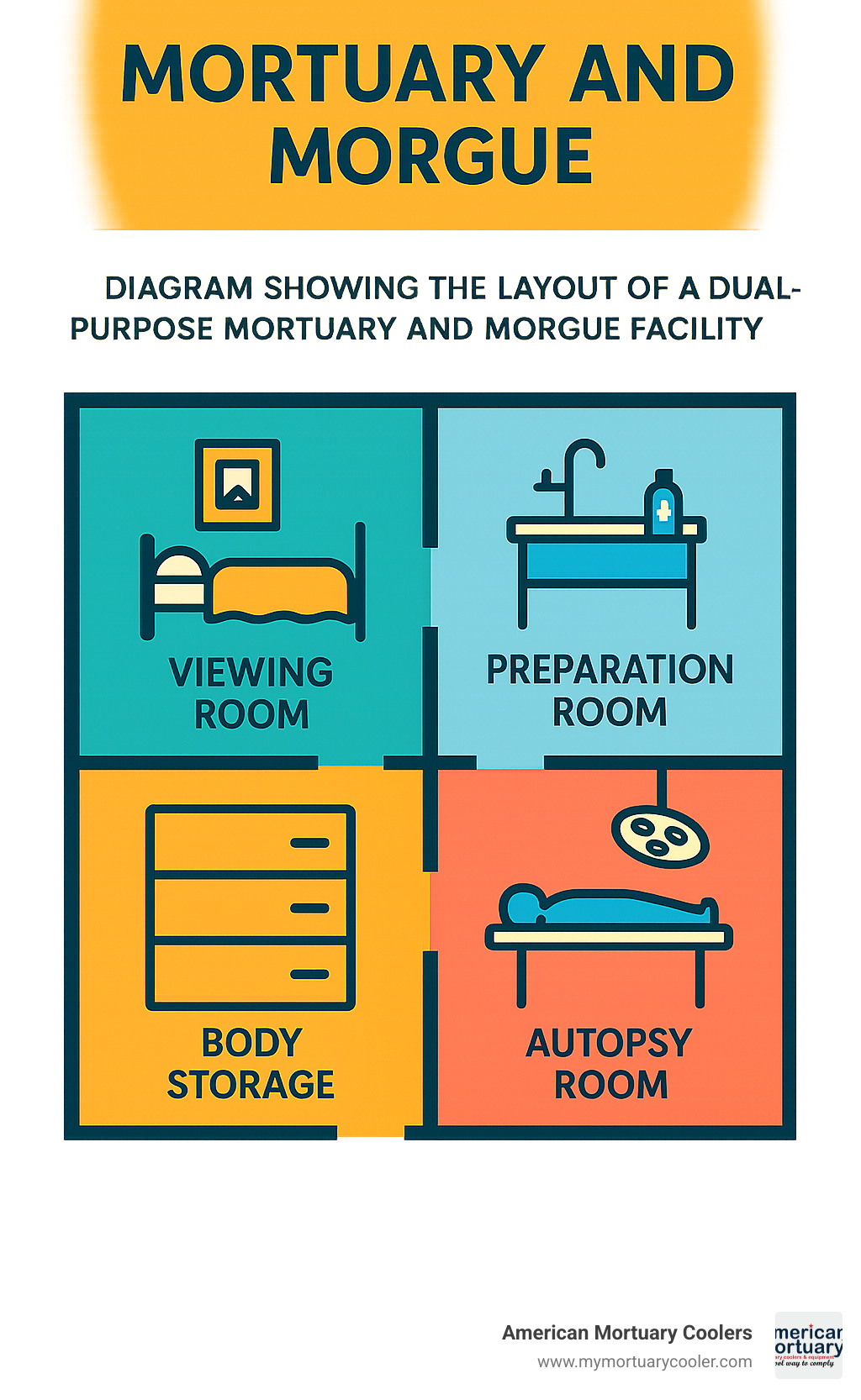
In these combined facilities, maintaining strict workflow protocols is essential, with clear separation between forensic and funeral functions.
During extraordinary circumstances like mass fatality events, communities sometimes establish temporary morgue facilities using refrigerated trucks or other large refrigerated spaces.
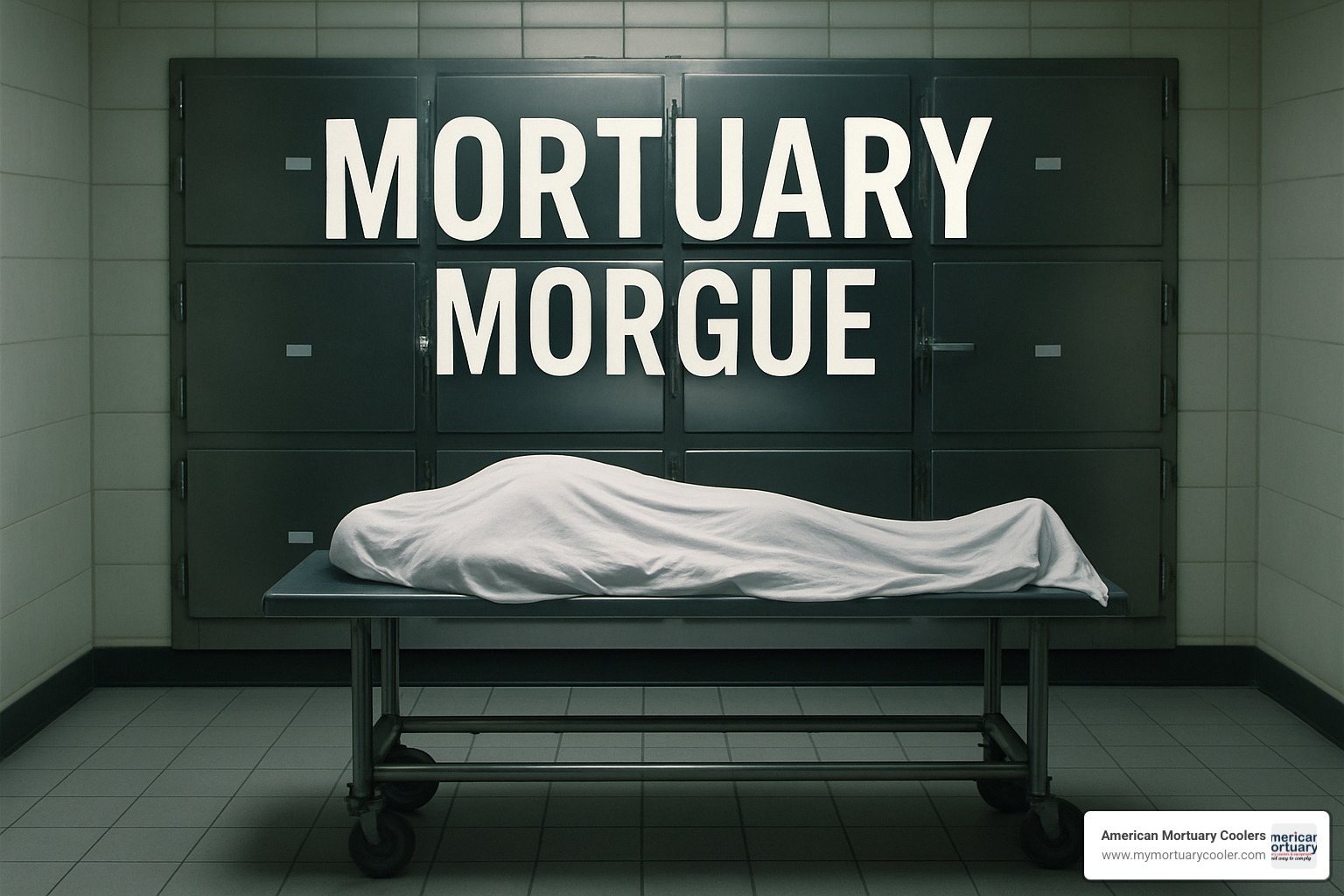
At American Mortuary Coolers, we've supplied refrigeration solutions for both standalone and combined facilities, understanding the unique requirements each situation demands.
Latest research on temporary morgues
Equipment, Standards & Costs
When it comes to mortuary or morgue facilities, the equipment isn't just functional—it's essential for preserving dignity and ensuring public health standards.
The heart of any facility is its refrigeration system. Modern units maintain bodies at precise temperatures—typically between 2-4°C (36-39°F) for standard storage, with freezers running at -10 to -50°C (14 to -58°F) when longer-term preservation is needed.
Beyond cooling, daily operations rely on specialized body handling equipment. Hydraulic lifts, transfer carts, and body boards ensure dignified transportation throughout the facility. Preparation areas feature stainless steel tables with proper drainage systems, alongside embalming machines and specialized instruments.
Safety equipment is standard in these environments, with staff using appropriate personal protective equipment—disposable gloves, gowns, and face shields, with specialized protective clothing for cases involving infectious disease.
All this equipment must meet stringent regulations from multiple authorities, including OSHA workplace safety standards, EPA environmental regulations, and state health department requirements.
Why Proper Coolers Matter
Refrigeration isn't just another piece of equipment—it's the foundation of everything that happens in a mortuary or morgue.
Proper cooling preserves dignity when families come to view their loved ones and when religious ceremonies need to take place. From a practical standpoint, effective cooling systems protect public health by preventing decomposition that could create sanitation issues or expose staff to pathogens.
Well-designed coolers, like those we provide at American Mortuary Coolers, offer energy efficiency that translates to lower operating costs over time. They provide appropriate capacity planning, reliable performance during peak demand periods, and reduced maintenance requirements.
What makes an effective cooling system? Temperature consistency throughout the storage area, rapid cooling capability, backup systems to prevent failures during power outages, easy-to-clean surfaces, and durable construction for 24/7 operation year after year.
More info about walk-in mortuary refrigerator specs
Budgeting: Typical Fees for Services
Understanding the costs associated with mortuary or morgue services can help families prepare financially during an already difficult time.
For morgue-related costs:
- County or hospital morgue storage: $50-150 per day after an initial holding period
- Private autopsies: $2,500-5,000 (medical examiner autopsies are usually covered by the county/state)
- Body release and transfer fees: $150-500
- Death certificate filing: $10-25 per copy
For mortuary and funeral home services:
- Basic services fee: $2,000-3,000
- Transfer to funeral home: $250-500
- Embalming: $500-1,200
- Preparation without embalming: $250-500
- Viewing/visitation services: $400-600
- Funeral services: $500-1,000
- Caskets: $1,000-10,000+
- Direct cremation: $600-1,200
- Cremation with services: $2,000-4,000
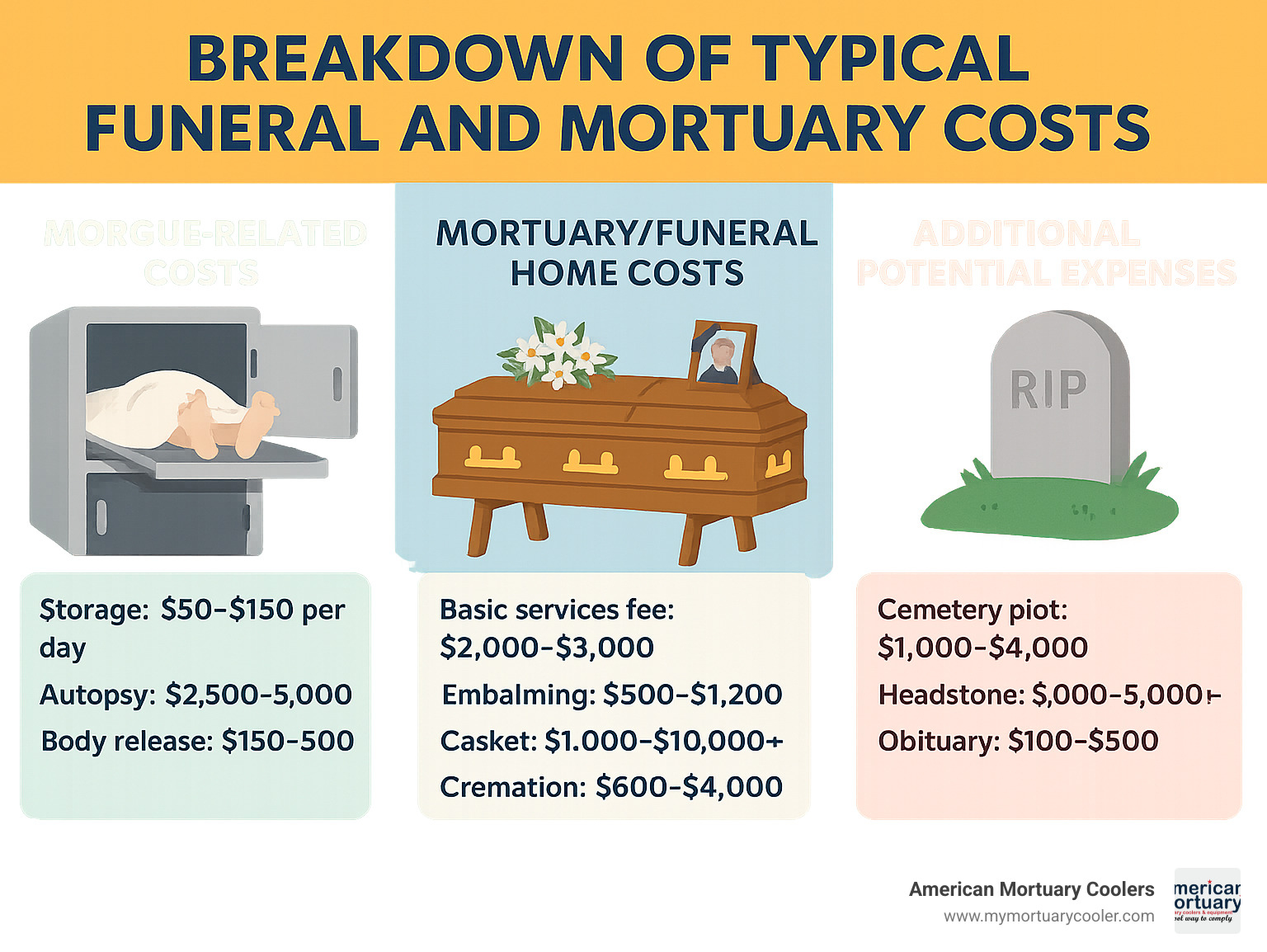
Additional expenses may include cemetery costs, headstones, obituary publication, flowers, transportation, and reception expenses.
Many funeral homes offer package deals that combine services at slightly reduced rates. The Federal Trade Commission's Funeral Rule requires funeral homes to provide itemized price lists and allow consumers to select only the services they want.
At American Mortuary Coolers, we work with facilities nationwide to provide cost-effective refrigeration solutions that help them manage operating costs while maintaining the highest standards of care.
Frequently Asked Questions about Mortuary or Morgue
How cold are bodies kept?
In a standard mortuary or morgue refrigeration unit, bodies are kept between 2°C (36°F) and 4°C (39°F) – similar to your home refrigerator.
This temperature range slows down natural decomposition processes without freezing the tissues, which would complicate later preparation. It also preserves evidence when forensic examination is needed and maintains the body's condition for family viewings or identification.
For longer storage, freezer units maintain temperatures from -10°C (14°F) to -50°C (-58°F), significantly slowing decomposition for weeks or even months.
At American Mortuary Coolers, we design our refrigeration systems with precision temperature controls and reliable backup systems to ensure consistent cooling even during power fluctuations or mechanical issues.
Who performs the autopsy?
The person who performs an autopsy depends largely on the circumstances of death and local regulations:
- Forensic pathologists – medical doctors with specialized training in pathology and forensic medicine who have completed medical school, pathology residency, and forensic pathology fellowship
- Medical examiners – typically forensic pathologists who serve as appointed or elected officials responsible for investigating deaths in their jurisdiction
- Coroners – in some counties, these officials (who may not be physicians) investigate deaths and order autopsies when necessary, though they typically have a forensic pathologist perform the actual procedure
- Hospital pathologists – may perform autopsies for natural deaths in hospital settings when families request information about medical conditions
These professionals help provide answers for families and, when necessary, evidence for the justice system.
Do families ever visit the morgue?
Yes, families do visit morgues more often than many people realize, though these visits serve specific purposes:
- Identification of the deceased – when someone passes away without identification or when visual confirmation is required
- Family viewings before transfer – for religious and cultural traditions requiring prompt viewing or specific rituals
- Collecting personal belongings – items found with their loved one or signing necessary documentation
- Cultural and religious practices – some traditions require family members to wash and prepare the body or perform specific rituals
These visits typically happen by appointment in designated areas separate from examination rooms. Many newer facilities have created more welcoming spaces specifically for family interactions.
At American Mortuary Coolers, we partner with facilities to design refrigeration systems that support these meaningful family moments while maintaining proper conditions for the deceased.
Conclusion & Next Steps
Understanding the differences between a mortuary or morgue helps immensely when you're navigating the practical aspects of death care. Throughout this guide, we've explored how these facilities serve different but complementary roles.
A morgue primarily handles the medical and legal aspects - the storage, examination, and sometimes investigation of deaths. A mortuary, on the other hand, is where the ceremonial journey begins - where preparation happens and where families come for viewings.
Your loved one might pass through both facilities, depending on the circumstances of their death. Behind the scenes at both places, proper refrigeration equipment plays a crucial role in preserving dignity and protecting public health.
When making arrangements after losing someone dear to you:
- Don't hesitate to ask questions about where your loved one is being cared for
- Know your rights under the FTC Funeral Rule and state regulations
- Communicate cultural and religious needs early in the process
- Compare services and costs from multiple providers when selecting a funeral home
- Consider pre-arranging to lift a burden from your family's shoulders during their time of grief
Here at American Mortuary Coolers, we're proud to support the funeral industry with refrigeration solutions that enable dignified care. Our Tennessee-based team designs custom coolers that meet the specific needs of facilities across the country – from small-town funeral homes to busy medical examiner offices.
We understand the varied needs of mortuary and morgue facilities nationwide and can deliver throughout the contiguous 48 states. Our team is always available to consult on refrigeration requirements, capacity planning, and energy-efficient solutions.
More info about our one-stop shop for mortuary coolers
Whether you're a funeral professional looking to upgrade your facility or a family seeking to better understand the process, we hope this guide has provided helpful insights into the important role that mortuaries and morgues play in our communities.
















